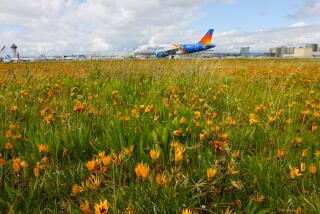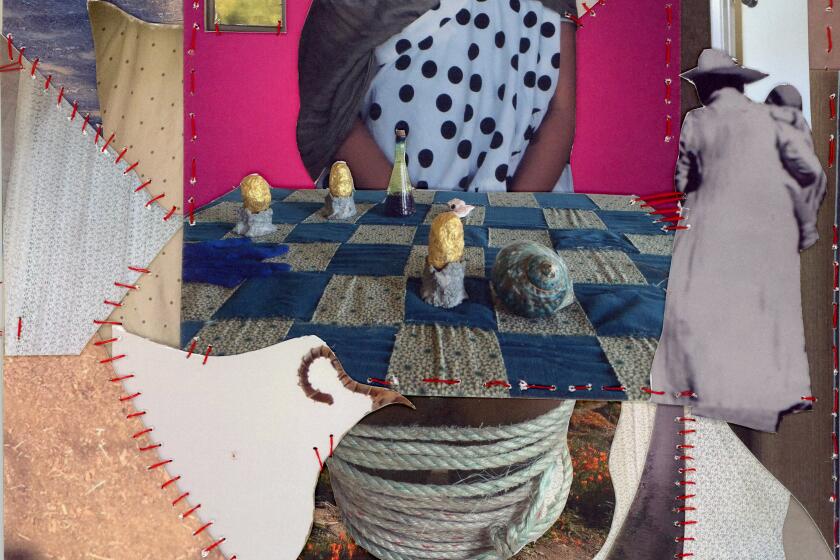How to pick wildflowers for your garden
BEFORE scattering wildflower seeds, consider height, color, bloom time and benefit to the species that pollenate the plants you are sowing. The following recommendations include picks from Carol Bornstein, Davis Fross and Bart O’Brien, authors of “California Native Plants for the Garden.”
WHAT TO PLANT
Low growing
Baby blue eyes (Nemophila menziesii) and five-spot (Nemophila maculata): Blue and white flowers, shade tolerant, pretty in containers. Grows to 10 inches.
Blue-eyed grass (Sisyrinchium idahoense bellum): Actually a mini-iris and perennial, this early- to mid-spring bloomer should be started in a pot; otherwise, it’s likely to be weeded out with crab grass. Does well along paths and borders in semi-shade with other native irises. Can tolerate full sun but will burn up midsummer. Cut it back and wait for it to return in the winter. Grows to 6 inches.
California goldfield (Lasthenia californica): Bright yellow show, good for butterflies. Grows 6 to 12 inches.
California poppy (Eschscholzia californica): The state flower is an early bloomer with repeat blossoms through fall. Typically annuals but can perennialize for two seasons. Brilliant orange; hybrid in white and second blossoms in yellow. Combine with almost any other wildflower. Attracts bees. Grows 8 to 12 inches.
Chinese house (Collinsia heterophylla): White and purple flowers. “California Native Plants for the Garden” authors recommend combining them with poppies and bunch grasses. Commercial seed mixes can result in spotty germination, stranding an occasional beauty queen in masses of poppies and flax. Grows 6 to 15 inches.
Globe gilia, or blue thimble flower (Gilia capitata): Blue flowers with bright green leaves. Combine with poppies and tidytips. Attracts bees. Grows 6 to 24 inches.
Tidytip (Layia platyglossa): Early bloomers. Yellow daisy-like flowers. Superb butterfly plant. Combine with globe gilia and lupine. Usually grows 6 to 12 inches but can reach 2 feet.
Medium to tall:
Arroyo lupine (Lupinus succulentus): Blue flowers, early bloomers. Superb for caterpillars, bees and hummingbirds. Don’t bother planting if you have snails; these flowers are caviar to gastropods. Grows 24 to 36 inches.
California aster (Lessingia filaginifolia): Perennial shrub with handsome, dirty-pink flowers. Terrific butterfly plants and valuable as late-season bloomers. Hybrid ‘Silver Carpet’ praised by “California Native Plants” authors for silvery foliage and ability to hug ground in a broad mat. Grows 12 to 36 inches.
California desert bluebell (Phacelia campanularia) and tansy leaf phacelia, also called wild heliotrope (Phacelia tanacetifolia): Essential for gardeners who love blue, deep, dark blue and lavender flowers. Bluebell grows 6 to 18 inches; tansy leaf phacelia usually grows 24 to 36 inches.
Elegant tarweed, or common madia (Madia elegans): Yellow daisy-like flowers. Exceptional stamina, late bloom, important for butterflies. Grows 6 inches to 3 feet.
Farewell-to-spring (Clarkia amoena): Stunning pink flowers. Superb late bloomer. Leave them to dry out and spill their seeds as elegiac salutes to summer. Grows 12 to 24 inches.
Red monkey flower (Mimulus puniceus) and other monkey flowers: perennial shrub, hummingbird favorite. Most grow 1 to 5 feet.
Sunflower (Helianthus annuus): Rises 2 to 5 feet with branching stems and blooms that repeat through autumn. Plant away from irrigation.
SEED SOURCES
Poppies are good choices if you are buying seeds in a chain store. Armstrong Garden Centers carry Botanical Interests, a good supplier, and recent visits to four Home Depots turned up 2008 Stover seed at all locations -- far better than at competing chains.
Beyond that, beware. Stover’s “California wildflower” mix includes nasturtiums, an invasive South American plant that will choke out poppies before our state flower has a chance to bloom. In fact, view any mixes labeled “Western” or “California” with suspicion, preferring mixes specifically labeled “California native.” Better yet, go to specialist purveyors in person or online.
Larner Seeds in Bolinas, Calif.; (415) 868-9407; www.larnerseeds.com.
Theodore Payne Foundation for Wildflowers and Native Plants, 10459 Tuxford St., Sun Valley; (818) 768-1802; www.theodorepayne.org.
S&S Seeds (wholesale supplier, for orders of $100 or more) in Carpinteria; (805) 684-0436; www.ssseeds.com.
REFERENCE
“California Native Plants for the Garden” by Carol Bornstein, Davis Fross and Bart O’Brien (Cachuma Press, 2005).
S&S’s Seed Selection Guide, www.ssseeds.com/pdf/SSSeeds_Guide .pdf.
“Fay’s Wildflower Meadow” by Barbara Eisenstein, horticulture outreach coordinator at Rancho Santa Ana Botanic Garden, www.rsabg.org/content/view.
CONSERVATION NOTE
Flinging wildflower seeds -- particularly poppy seeds -- from car windows has come to be seen as a “green” thing. It’s not. The success or collapse of wildflowers that are truly wild depends on the way their genes have adapted to harsh conditions. When commercial breeders produce seed for home gardens, they breed out these wild traits for predictable annual blooms; that’s why domestic seed loses the ability to endure a prolonged drought while wild seed doesn’t.
For this reason, Caltrans and professional teams working on restoration projects in or around wild areas never use garden-issue seed. They painstakingly collect local wild seed to keep the genetics of the local flora strong. Wildflower fanciers should never strew commercial seed near wild, open or rural areas. For the California Native Plant Society’s policy on sowing wildflowers: www.cnps.org/archives/wildflowers .htm.
--
Emily Green
More to Read
Sign up for our L.A. Times Plants newsletter
At the start of each month, get a roundup of upcoming plant-related activities and events in Southern California, along with links to tips and articles you may have missed.
You may occasionally receive promotional content from the Los Angeles Times.






